If you’ve found your dream home, but it’s showing signs of movement, you’re probably wondering if it’s a good idea to buy a house with subsidence.
It’s a common question as many houses in the UK do show signs of subsidence. However, you’ll be pleased to know it’s often not as big a deal as you may first think.
Drawing from our own experience, we’re going to take a look at the key things you need to know to answer the question of should you buy a house with subsidence?
While subsidence can be a serious issue, it shouldn’t put you off your dream property.
We can’t tell you if you should buy a house with subsidence or not, but we can give you a step-by-step guide that will help you make that decision.
1. Spotting Signs Of Subsidence
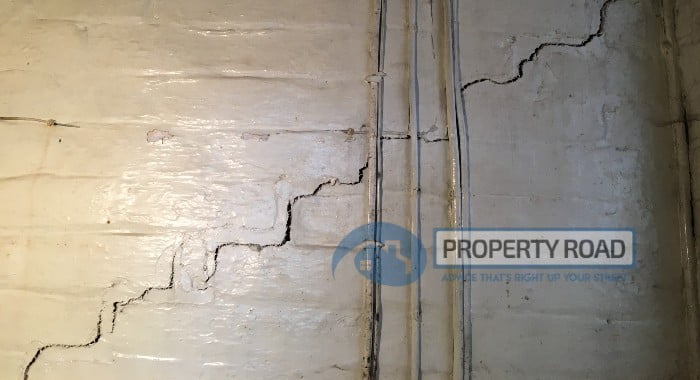
Subsidence is when the walls of a building have moved since they were built.
The movement often causes cracks to appear along the walls. When subsidence is severe, it can lead to significant structural issues for properties.
So the first step is to actually spot signs that subsidence might be a problem in a property you view.
There are a number of telltale signs that a property has subsidence, including:
- Significant cracking of walls
- Sloping floors
- Twisted window or door frames
In short, vertical or horizontal cracks tend to be the most serious, though stepped cracks can be an issue too.
If a crack is visible on both sides of the wall or is wider than the thickness of a 10p coin then it indicates potentially serious problems. Sloping floors and twisted window or door frames are usually only serious if significant.
It’s important to look out for any of these signs when viewing a property.
We have a guide about spotting sings of subsidence that will give you much more detailed information and is worth reading if you are concerned about a property you are interested in.
You should also know that a seller is obliged to declare if subsidence is present.

This is now part of the conveyancing process as the seller is asked to complete a Property Information Form.
On the form, they’ll be asked several set questions for which they must provide full and accurate answers. Failure to do so can result in legal proceedings if it’s suspected they deliberately withheld the truth.
So, even if you don’t spot any signs while viewing the house, the form should bring up any issues. Of course, this also means that you will have to declare the subsidence when you come to sell the house. Something to keep in mind.
When we sold our house with subsidence, we were very open about it, if any viewer asked the question. Because we had a structural surveyor report that confirmed that it was long-standing and non-progressing, it didn’t cause any issues.
While it might put off some potential buyers, in our experience, it is always better to be truthful upfront rather than having to deal with more serious issues further down the line.
2. Getting A Survey Done
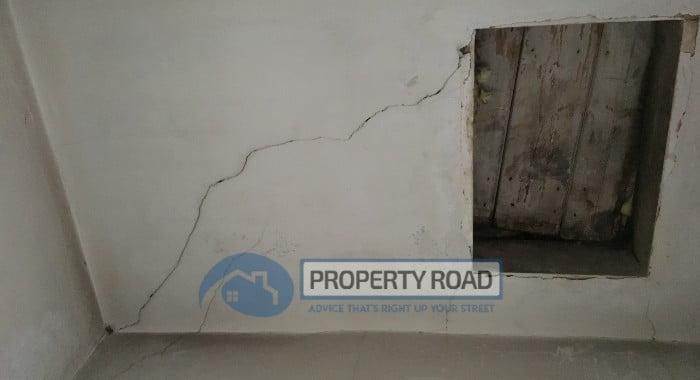
If you have spotted any signs but really like the property, then the next step is to get an expert in. As we have said, just because there are signs of subsidence, doesn’t mean that it’s a huge problem.
A good chartered surveyor will be able to check on the severity of any subsidence and advise you on any necessary remedial work that will be needed.
This will be done via a property survey, of which there are a few to choose from. You can arrange for a homebuyers report or a full structural survey.
In our experience, it’s always best to choose a full structural survey if you are concerned about subsidence. Not only will it be conducted by a structural engineer, their report will normally be covered by insurance.
What you are ideally looking for are the magic words ‘long-standing and non-progressive’ as this will mean only cosmetic work is required.
However, if the surveyor thinks the subsidence is recent or still progressing, they will still advise on the likely costs of repairing the problem.
There are several possible causes of subsidence in houses and other properties. These are also discussed in further detail in Has Your House Got Cracks: A Homeowner’s Guide to Subsidence and Heave Damage by Freeman et al. (1994). The most common include:
- Mining having taken place in the area
- Different ground types
- Trees and bushes too close to the property have damaged the foundations
- Leaking pipes and guttering washing away soil and cause movement
- Inadequate foundations
An example of subsidence caused by mining was observed in the vicinity of the salt mines of Cheshire (Bell et al., 2000). Its widespread effects even led to the Brine Pumping (Compensation for Subsidence) Act of 1891.
Trees and bushes close to the walls of a property can also cause issues with movement and subsidence. The problem is so widespread that this type of subsidence is the most common tree-related insurance problem in the UK (O’Callaghan, 2005).
The survey report will tell you which of those is the cause of the subsidence and how to fix it. Crucially, the report will also tell you how much this will cost you.
Knowing this will get you a step closer to answering the question of should you buy a house with subsidence.
3. Checking With Your Mortgage Company
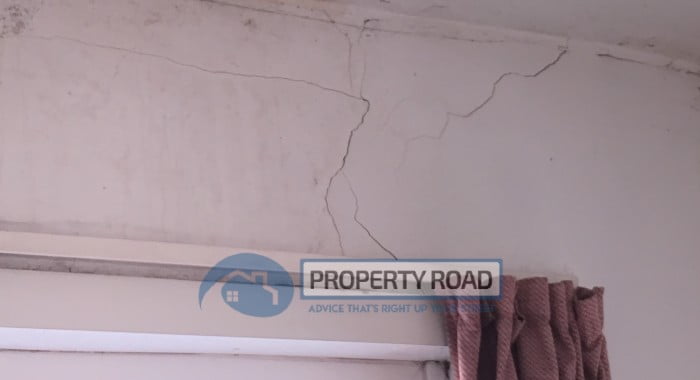
Now that a structural survey has confirmed that your dream property has subsidence, it’s time to check with your mortgage lender.
While you can get a mortgage on a property with subsidence, it will depend on how severe the subsidence is and whether it affects your ability to get insurance on the property.
Most mortgage providers will insist that you hold valid buildings insurance for the duration of your mortgage. This is because it helps to protect their investment.
Therefore, if the subsidence is so bad you can’t get insurance, you’ll probably find it hard to mortgage the property.
However, this is rare since most subsidence is solvable and many insurers will still insure you but just with larger excesses on subsidence claims. It’s worth mentioning that it’s possible that high street lenders might reduce the value of the property or the amount they are willing to lend you.
Another possibility is that they stipulate that you have to fix the issue within a given timeframe. Worst case scenario is that they won’t lend to you at all.
So it might be necessary to go to a specialist lender for properties with subsidence. Of course, this means that borrowing money will cost you more.
A good mortgage advisor will be able to help advise you on the best way to get a mortgage for a property with subsidence.
Buying A Property? FREE Step-By-Step Platform
4. Assessing Your Position
Once you know what you are dealing with, how to fix it, how much it will cost you and what extra costs you would incur for mortgage and buildings insurance, it’s decision time.
First ask yourself: Do you love the house enough to put up with any work you have to carry out to fix the problem?
When subsidence is considered to be causing structural issues to a property, underpinning is often the best solution. In fact, the most common type utilized in the UK can be attributed to partial underpinning (Anumba & Rafiq, 1995).
This involves digging down below the foundations of the property and pouring in a concrete mix. Sometimes beams are also used, but the aim is the same – to provide added support and strength to the building to prevent further movement.
It can take several weeks and will involve noise, dust and dirt. So, unless you are prepared for this, you might want to reconsider.
If you answer the first question with yes, you need to look at your financial position. Can you get a mortgage that you can afford? Will you be able to get buildings insurance at a reasonable price?
These are important questions, because you don’t want to end up having to pay more than you can afford. But if the figures stack up, and you are happy to proceed, you are ready for the next question.
How much can/do you want to pay for the property? Given the extra costs you will have to face, the asking price you agreed might be too high.
At this point, it’s probably time to renegotiate the price with the seller. You can use the surveyor’s report as supporting evidence for why you need to reduce your offer.
If your mortgage payments have increased due to the subsidence, also mention this, as it will give you more ammunition.
This will put you in a good position, because it’s likely to put off other buyers too. And by showing that you are willing to buy the property anyway, you present yourself as an attractive buyer, despite lowering your offer.
Of course, once you have started to negotiate a new price with the seller, you have already decided to buy the house with subsidence. But make sure that you get the house at the right price.
And don’t be afraid to walk away if the seller isn’t willing to come down enough for you to afford to fix the issues appropriately.
So here you have it, don’t be put off by a house showing signs of subsidence. As long as you know exactly what you let yourself into and can afford to fix the problem, buying a house with subsidence doesn’t have to be a disaster.
If you follow our four steps, you will be able to make a decision that is right for you.
Our Experience Of Buying A House With Subsidence

Having lived in an area with a strong mining history for a good number of years, most houses we looked at had signs of movement.
This being a relatively normal occurrence in the area, we weren’t put off by it. And one of the homes we have bought over the years had subsidence.
The first sign we spotted was a crack under a window of the extension that was replicated on a retaining wall in the back garden. Because the two cracks seem to run along the same line, it was likely that there had been some movement, which can often also mean subsidence.
We really loved the house, so didn’t want to dismiss it because of that. While the extension had been built decades ago without any issues, which would suggest that the movement might be non-progressing, it wasn’t built according to building regulations.
We found that this is always a red flag, because whoever built it might have cut corners for financial reasons, which might mean the extension might not be structurally sound. However, the only way to be sure is to have a structural survey done.
And that’s exactly what we did. We told the surveyor about our concerns beforehand, so he would pay special attention to the extension and the retaining wall below it in the garden.
In our experience, it’s always a good idea to mention any concerns you have about a property to any surveyor you engage.
Thankfully, the report he sent us was not the disaster we were fearing. He did confirm that there was movement, evidenced by the load bearing wall bulging out. This meant that the weight of the extension had pushed the wall outwards.

However, the structural engineer said that this movement was long-standing and non-progressive. In effect, it was more a case of settlement rather than subsidence. This was a relief, because it meant that no further movement was to be expected.
There were some repairs and remedial works he did recommend though. The walls with the cracks needed repointing.
And he also pointed out that the foundations of the retaining wall with the crack were exposed.
While this wasn’t responsible for the movement, the structural report said that this will weaken the wall, which could lead to issues further down the line. He suggested raising the floor level above the foundations as a remedial measure.
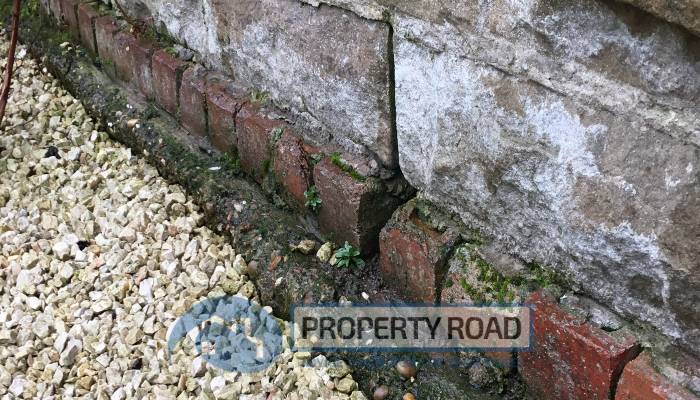
After we bought the house, we did carry out any work that the structural surveyor recommended. We also got a builder in to install wall ties on the retaining wall, just to be sure. While this was not necessary according to the structural survey report, it did give us peace of mind.
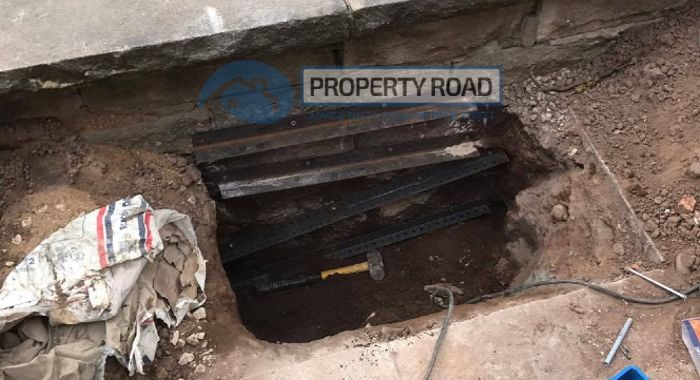
In our experience, buying a house with subsidence doesn’t have to be a problem. But it is important that you know exactly what you are dealing with, which is only possible if you get a structural engineer in to do a structural survey.
Then it’s just a question of affordability. Can you afford to make any recommended repairs? You might have to renegotiate the price with the seller. In particular, if the repairs aren’t just cosmetic, you will be in a good position to offer a lower price.
And it’s definitely worth it, if you get the home you have fallen in love with, like we did.
When Subsidence Is A Dealbreaker
But we weren’t always that lucky. Sometimes the answer to the question of should you buy a house with subsidence is probably not.
We had to pull out of a purchase once because the mortgage company wouldn’t lend us money on the property we wanted to buy due to subsidence.
The house we looked at had a single brick garage, on top of which the owners built an extension. Because the foundations for the garage weren’t made to carry the weight of a second storey, there were cracks in the garage walls.
This didn’t put us off at first, because we bought a house that had signs of subsidence before. The location was perfect, so we got a builder to have a look at it. He told us what we would need to do to fix it and how much it would cost.

Our offer reflected the additional costs and was accepted. Unfortunately, our mortgage company told us after the valuation, that they wouldn’t give us a mortgage on this property. We tried to negotiate with them to see if anything could be done, such as reducing the valuation of the property.
But they were very clear that they would not lend us money for this property. So we had no choice but to withdraw our offer. We were gutted, but we couldn’t do anything else.
As our experience shows, sometimes subsidence can be a dealbreaker, literally.





